TRAVEL MEMORIES: BOLZANO,BOZEN, BULSON
Lucia Rota Andersen
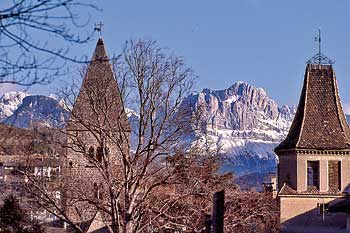 The city has three names: in Italian, German and Ladin, because there are three linguistic groups. The largest group is Italian, which accounts for 73%, followed by German with 26.29% and Ladin with 0.71 %, spoken mostly in the valleys of the Dolomites. Before the annexation of Bolzano by Italy and the forced Italianisation, 94% of the residents of Bolzano spoke German. The city has three names: in Italian, German and Ladin, because there are three linguistic groups. The largest group is Italian, which accounts for 73%, followed by German with 26.29% and Ladin with 0.71 %, spoken mostly in the valleys of the Dolomites. Before the annexation of Bolzano by Italy and the forced Italianisation, 94% of the residents of Bolzano spoke German.
The 79th international congress of the Dante Alighieri Society took place in Bolzano and Merano last September. Almost 300 delegates attended from the entire world.
The theme was “History, Art and Language around the Alps: Multilingualism as the Foundation of European Identity”. Bolzano was selected because it is a place where different languages and cultures meet, a strategic junction for relations between Italy, Austria, Switzerland and Germany, a place with natural and artistic beauty and a model for ethnic integration from many points of view.
I stayed at the Hotel Regina near the Bolzano train station. From my window, I had a splendid view of the mountain called “Il Catinaccio”, which I often visited when I lived in Italy and also when I lived in Denmark and returned to Italy, especially to see my mountains, the Dolomites, again. I remember the joy I felt just being there, the more or less strenuous climbs, its mysterious castles, stopping at the mountain huts, the tasty dishes, its colours, songs and legends, especially the one about King Laurino: Once upon a time, King Laurino ruled a nation of dwarves and was a dwarf himself. 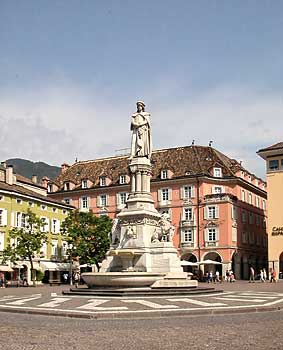 He lived in a fortified castle on the Catinaccio. This king's pride and joy was a beautiful garden of red roses. In addition to his flowers, this great little king fell so much in love with a beautiful princess who lived in a nearby castle that he decided to abduct here and carry her off to his castle. Similde's desperate brother called for the help of the other knights to free Similde and defeat King Laurino. Before dying, he said: “May no one ever enjoy the splendour of my garden neither by the light of day nor in the shadows of the night.” He forgot to mention sunset. In fact, since then, during certain sunsets, the Catinaccio, which in German is called Rosengarten (rose garden), is ablaze with tones of pink that are reflected in the blue sky. He lived in a fortified castle on the Catinaccio. This king's pride and joy was a beautiful garden of red roses. In addition to his flowers, this great little king fell so much in love with a beautiful princess who lived in a nearby castle that he decided to abduct here and carry her off to his castle. Similde's desperate brother called for the help of the other knights to free Similde and defeat King Laurino. Before dying, he said: “May no one ever enjoy the splendour of my garden neither by the light of day nor in the shadows of the night.” He forgot to mention sunset. In fact, since then, during certain sunsets, the Catinaccio, which in German is called Rosengarten (rose garden), is ablaze with tones of pink that are reflected in the blue sky.
At dusk, I used to open the window of my room hoping to see those colours and, miraculously, I saw them.
In the morning, at 8:00, I walked to the congress, which was held at the modern University of Bolzano, where three languages are spoken: Italian, German and English.
I used to stop in Piazza Walther von der Vogelweide, where there is a statue dedicated to the great Medieval poet who is believed to have been born near Bolzano. The piazza was always crowded. Many people sat at the tables of the many cafés to enjoy the local sweets. Sometimes, a blond singer in a Tyrolean costume greeted the passers-by with her cheerful “ich jodle auf der Berge”.
The majestic Cathedral dominates the piazza. It is a jewel of Romanesque-Gothic art that could easily compete with Notre Dame in Paris. It has a curious little door called the “Wine Door” that portrays a couple of wine-makers in the typical costume of the time. The tall bell tower alongside seems to be aiming directly at the sky.
I used to continue on to the Church of the Domenicani. I would go inside. In the rear of the church between the chorus and the sacristy, there is the famous 14th-century Chapel of San Giovanni, which was commissioned by a Florentine who made it the family funeral chapel. Magnificent frescoes entirely cover the walls of a narrow, rectangular space. They are the work of artists from the school of Giotto, as demonstrated by the identical details found in the Chapel of the Scrovegni in Padua.
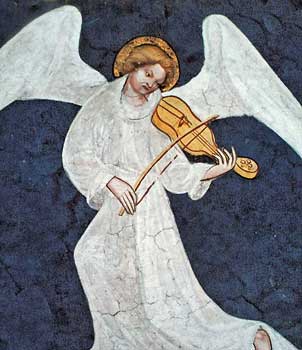 A glance at my watch told me that I needed to hurry off to the congress. A glance at my watch told me that I needed to hurry off to the congress.
In the late afternoon, I returned to the hotel along Via dei Portici, a beautiful pedestrian area in the old town centre. The people of the Alto Adige come here to shop, look at store windows featuring the work of local artisans, browse the well-stocked bookstores and dine in the cafés and restaurants. Via dei Portici takes time. Here, 18th-century Bolzano lives on in its buildings, fountains and the signs of some of the shops.
A brief rest at the hotel, a special salute to the Catinaccio and then out to dinner at Castel Mareccio, one of Bolzano's four castles.
It is an ancient manor was renovated in the 1980s; it is surrounded by a vineyard and has halls embellished by frescoes from the late Tyrolean Renaissance. The dinners were always exquisite, made even more charming by Renaissance music played by a quartet seated in a loggia above the hall.
Bolzano also has many important museums, including one dealing with archaeology. Here, you can “see” Ötzi, the man found in the ice who lived 3,300 years ago. He was discovered in 1991 on the border between Austria and Italy. He has been a guest of the museum since 1998. He was 46 years old, 5 feet, 3 inches tall and perfectly equipped for life in the upper mountains. 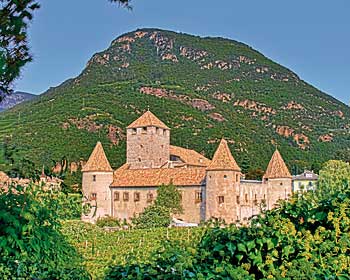 He had an arrow in his left shoulder that probably killed him.... What do you think? Once in Bolzano, wouldn't it be worth the trouble to visit the Dolomites, as well? He had an arrow in his left shoulder that probably killed him.... What do you think? Once in Bolzano, wouldn't it be worth the trouble to visit the Dolomites, as well?
Those who would like to get to know the Alto Adige, its history, how it is today and its beauty, can read Thomas Harder's book “En rejse i Sydtyrol” or attend the Sommerhojskole that Thomas and Lisbeth Davidsen will hold in the Tyrol.
Last November, some lucky people were able to participate in the conference at which Anita Petersen presented her Alto Adige (she was born in Merano); the conference was full of colour and beautiful Alto Adige landscapes and featured a tasting of local products. It was a real treat for those who would like to take a vacation in Dolomites. Bon voyage !
|
 NUMBER 9
NUMBER 9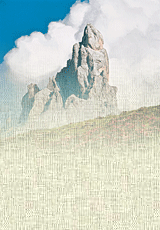
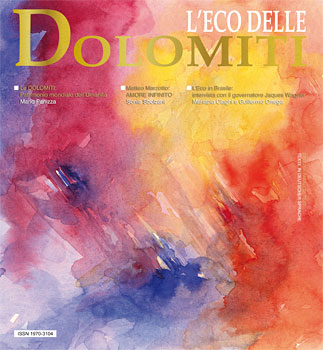
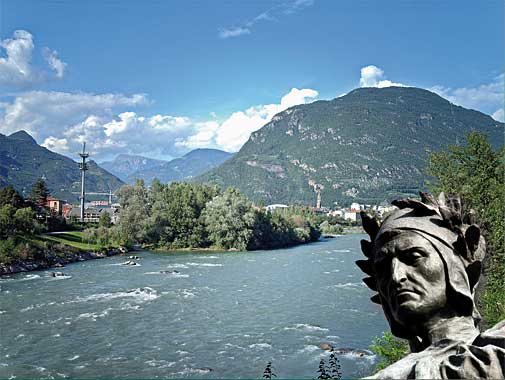
.jpg) The heads of the various participating committees have written many messages of thanks and congratulations, as well as descriptions of the Congress, that we are thinking of collecting them in a small publication that would also contain the articles that many committees had published in various magazines and newspapers throughout the world. We mention, as an example, the beautiful articles prepared by the Dante Committee of Benevento.
The heads of the various participating committees have written many messages of thanks and congratulations, as well as descriptions of the Congress, that we are thinking of collecting them in a small publication that would also contain the articles that many committees had published in various magazines and newspapers throughout the world. We mention, as an example, the beautiful articles prepared by the Dante Committee of Benevento.
 He lived in a fortified castle on the Catinaccio. This king's pride and joy was a beautiful garden of red roses. In addition to his flowers, this great little king fell so much in love with a beautiful princess who lived in a nearby castle that he decided to abduct here and carry her off to his castle. Similde's desperate brother called for the help of the other knights to free Similde and defeat King Laurino. Before dying, he said: “May no one ever enjoy the splendour of my garden neither by the light of day nor in the shadows of the night.” He forgot to mention sunset. In fact, since then, during certain sunsets, the Catinaccio, which in German is called Rosengarten (rose garden), is ablaze with tones of pink that are reflected in the blue sky.
He lived in a fortified castle on the Catinaccio. This king's pride and joy was a beautiful garden of red roses. In addition to his flowers, this great little king fell so much in love with a beautiful princess who lived in a nearby castle that he decided to abduct here and carry her off to his castle. Similde's desperate brother called for the help of the other knights to free Similde and defeat King Laurino. Before dying, he said: “May no one ever enjoy the splendour of my garden neither by the light of day nor in the shadows of the night.” He forgot to mention sunset. In fact, since then, during certain sunsets, the Catinaccio, which in German is called Rosengarten (rose garden), is ablaze with tones of pink that are reflected in the blue sky. A glance at my watch told me that I needed to hurry off to the congress.
A glance at my watch told me that I needed to hurry off to the congress. He had an arrow in his left shoulder that probably killed him.... What do you think? Once in Bolzano, wouldn't it be worth the trouble to visit the Dolomites, as well?
He had an arrow in his left shoulder that probably killed him.... What do you think? Once in Bolzano, wouldn't it be worth the trouble to visit the Dolomites, as well?